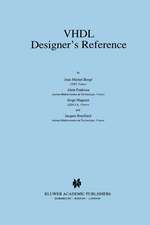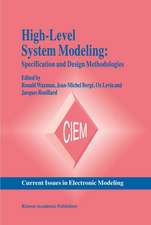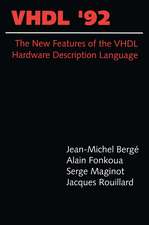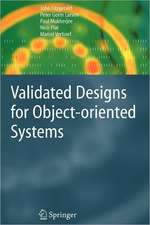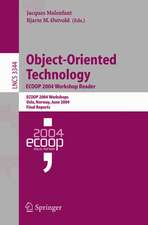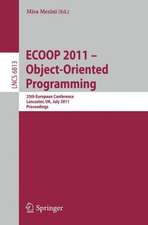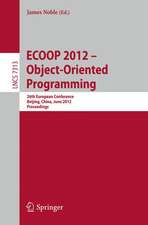Object-Oriented Modeling: Current Issues in Electronic Modeling, cartea 7
Editat de Jean-Michel Bergé, Oz Levia, Jacques Rouillarden Limba Engleză Hardback – 31 oct 1996
The seven chapters comprising this book provide an overview of the latest object-oriented techniques for designing systems and hardware. Many examples are given in C++, VHDL and real-time programming languages.
Object-Oriented Modeling describes further the use of object-oriented techniques in applications such as embedded systems, telecommunications and real-time systems, using the very latest techniques in object-oriented modeling. It is an essential guide to researchers, practitioners and students involved in software, hardware and system design.
| Toate formatele și edițiile | Preț | Express |
|---|---|---|
| Paperback (1) | 1265.49 lei 6-8 săpt. | |
| Springer Us – 26 sep 2011 | 1265.49 lei 6-8 săpt. | |
| Hardback (1) | 1271.60 lei 6-8 săpt. | |
| Springer Us – 31 oct 1996 | 1271.60 lei 6-8 săpt. |
Preț: 1271.60 lei
Preț vechi: 1589.50 lei
-20% Nou
Puncte Express: 1907
Preț estimativ în valută:
243.35€ • 253.12$ • 200.90£
243.35€ • 253.12$ • 200.90£
Carte tipărită la comandă
Livrare economică 14-28 aprilie
Preluare comenzi: 021 569.72.76
Specificații
ISBN-13: 9780792396888
ISBN-10: 079239688X
Pagini: 150
Ilustrații: XVIII, 150 p.
Dimensiuni: 155 x 235 x 11 mm
Greutate: 0.42 kg
Ediția:1996
Editura: Springer Us
Colecția Springer
Seria Current Issues in Electronic Modeling
Locul publicării:New York, NY, United States
ISBN-10: 079239688X
Pagini: 150
Ilustrații: XVIII, 150 p.
Dimensiuni: 155 x 235 x 11 mm
Greutate: 0.42 kg
Ediția:1996
Editura: Springer Us
Colecția Springer
Seria Current Issues in Electronic Modeling
Locul publicării:New York, NY, United States
Public țintă
ResearchCuprins
1. Object Orientation: Modeling and Design Paradigms for the Year 2000?.- 1.1. Motivation.- 1.2. Software design.- 1.3. Hardware design.- 1.4. The Future of Hardware Design.- 1.5. The Influence of Object Orientation on the Design Process.- 1.6. Summary and Outlook.- 2. Object-Oriented Modeling of Hardware for Embedded Systems.- 2.1. Introduction.- 2.2. Data Types.- 2.3. Modeling Hardware Components as Classes.- 2.4. Deriving Specialized Components.- 2.5. Data Decomposition.- 2.6. Arithmetic Logic Unit Example.- 2.7. Type Genericity.- 2.8. Related Work.- 2.9. Conclusions.- 3. Object-Oriented and Real-Time Techniques: Combined Use of OMT, SDL and MSC.- 3.1. Introduction.- 3.2. The OORT engineering process.- 3.3. Overview of the OMT, MSC and SDL notations.- 3.4. Introduction to a combined use of OMT, MSC and SDL.- 3.5. OORT and the co-design.- 3.6. Conclusions.- 4. Integrated System Design with an Object-Oriented Methodology.- 4.1. Introduction.- 4.2. Methodology Outline.- 4.3. Analysis using OMT.- 4.4. Creating a System Model with OMT*.- 4.5. Paths to Implementation: SDL and VHDL.- 4.6. The INSYDE toolset.- 4.7. Case Studies.- 4.8. Conclusion.- 5. Object Orientation and Structural Design.- 5.1. Introduction.- 5.2. Outline.- 5.3. VHDL Structural Descriptions.- 5.4. Principles of Object Orientation.- 5.5. Structure and Object Orientation.- 5.6. An Inheritance Concept for Structural VHDL.- 5.7. Application Examples.- 5.8. Genericity.- 5.9. Conclusion and Outlook.- 6. Abstract Hardware Modelling Using an Object-Oriented Language Extension to VHDL.- 6.1. Introduction.- 6.2. Modelling Problems.- 6.3. Object-Oriented Techniques.- 6.4. Acceptance of New Design Techniques.- 6.5. Survey on the Object Modeling Technique from Rumbaugh.- 6.6. The Implementation Language.- 6.7. From Specification to Implementation.- 6.8. Parallelism in Hardware Systems.- 6.9. Specification and Implementation of Communication Mechanisms.- 6.10. Conclusion.- 7. Object-Oriented Generation of VHDL Models.- 7.1. Introduction.- 7.2. Object-Oriented Paradigm.- 7.3. Analysis of VHDL Model Generation System.- 7.4. VHDL Model Generation System.- 7.5. Example.- 7.6. Conclusions.











